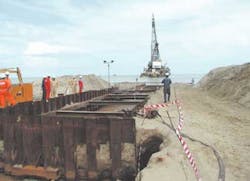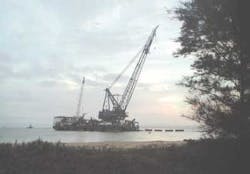Asia/Pacific: Large Asia/Pacific line extends Brunei field's life, cuts operating costs
The 30-year-old Ampa-Fairley petroleum facilities offshore Brunei in the South China Sea were revitalized earlier this year, in part due to efforts on behalf of Brunei Shell Petroleum (BSP), assisted by Global Industries Asia Pacific (Global Industries, Ltd subsidiary).
BSP anticipates that the Ampa-Fairley Rational-ization Project will extend the service life of these facilities 30-40 years and will save $20 million per year in operating costs.
Last year, production from the Western fields averaged 23 MMcf/d of gas and 88,000 bbl of oil and condensate per day. Developmental studies conducted during the 1990s indicated increased gas compression would be required as gas reservoir pressures drop. Therefore, simplification of Western fields operations and transfer of gas compression facilities to an onshore location were needed. Modifications would ensure simpler operation, greater efficiency, increased reliability, and more environmentally friendly and safer facilities.
The Western offshore fields of South-West Ampa, Fairley, Gannet, and Fairley Baram constitute approximately 80% of BSP's gas production and 40% of its oil production. Originally built in the 1960-1980 time span, most of the platforms, complexes, and equipment are nearing the end of their useful lives. Brunei Shell Petroleum and Brunei LNG (BLNG) committed to rejuvenate the fields' infrastructure to allow continued, reliable oil and gas production.
Project gains
Upon completion, the facility will export high pressure gas as well as HHP gas to BLNG. The high pressure gas will be compressed in new high pressure compressor modules at the onshore compression plant, near the existing BLNG plant, before being fed to BLNG trains along with the offshore HHP gas. The existing gas export pipelines will be reconfigured to allow for the export of HP gas to BLNG. In addition, the environmental benefits of the Project are significant, including:
- 77% reduction in total gas volumes vented
- 80% reduction in greenhouse gas emissions by vent to flare conversion
- 28% reduced sewage discharge.
The Rationalization Project includes the installation of an onshore compression plant, rationalization of the entire Ampa-Fairley offshore facility, and installation of two major offshore pipelines.
Global Industries'Asia Pacificexecuted the installation of a 33-km, 40-in. pipeline and a 6.5-km, 28-in. pipeline in depths to 130 ft. Installation of the 28-in. pipeline to carry low pressure gas from the Ampa 12 platform to Ampa 9 included stalk-on risers at each platform and six pipeline crossings.
The 40-in. pipeline, a high pressure wet gas trunkline, was installed from the existing Ampa 6 platform to the onshore compression plant and included a stalk-on riser at the platform, 15 pipeline crossings, and burial of the first 2 km of shore-side pipeline. The pipeline carries the higher volume high pressure gas, rather that the previous HHP gas, to the compression plant. Installation included 100 meters of onshore pipeline including tie-in to the offshore section at the beach. Pigging, testing, dewatering, and nitrogen purging of the two pipelines were part of the pre-commissioning process.
Largest line
The 40-in. pipeline installation in March and April, 2001, is the largest diameter pipeline to be installed in the Borneo region of Southeast Asia. The 5 km section of the 40-in. pipeline included an above-water tie-in of two sections in 50 ft water depth and was successfully completed in two days. The repair rate on the 40-in. pipeline was 0.3% or 8 repairs in 2,694 joints. During construction, the lay barge achieved a Global Industries' record lay rate of 214 joints of 40-in. pipeline in 24 hours.
In order to carry out this project, coated pipe was transported from Kuantan, Malaysia, to the site, requiring six separate spreads for 10 voyages. Upon arrival, each load of pipe was inspected for residual magnetism and weight coating damage.
During the 40-in. pipelay operation, mattresses were pre-installed for 10 of the 15 pipeline crossings. The maximum lay tension was 240 kips. A four-section stringer was used for a total length of 240 ft. The 40-in. pipeline was later left on the seabed with the buoyancy tanks for future recovery during the mid-point tie-in.
The automated ultrasonic technique, in conjunction with engineering critical assessment, was used for examining the welds of both pipelines instead of using the standard X-ray technique. Utilizing these technologies provided a better quality method for detecting defects in welds. BSP was the first to use this method of weld inspection in Southeast Asia.
The 40-in. pipeline was installed with subsea online corrosion monitoring equipment that allows a corrosion engineer at BSP onshore to monitor the condition of the pipelines. This is the first installation of its kind for BSP.


